Vascular: Fasciotomy
General Considerations
General Principles
- Skin & Fascial Incisions Should Extend the Entire Length of the Compartment
- All Compartments at Risk Should Be Opened
- Skin Incision Should Not Be Closed at the Initial Operation
Skin Closure
- Leave Open with Delayed Closure at 3-7 Days
- Delayed Primary Closure or Split-Thickness Skin Graft
- Issues of Early Wound Closure:
- Recurrent Compartment Syndrome from Continued Swelling
- Unable to Assess Nonviable Muscle/Tissue Which Can Lead to Infection
- Muscle Necrosis Occurs from the Inside-Out & May Require Further Debridement
- Skin Necrosis
- Delayed Closure Management
- Open with Wet-to-Dry Dressings
- Negative Pressure Wound Therapy
- “Shoelace Technique” (Gradual Suture Approximation) – Staples Along Edges with Vessel Loop Threaded in Crisscross Fashion and Tightened Every 48 Hours
- Dynamic Dermatotraction & Static Tension Devices – Less Popular
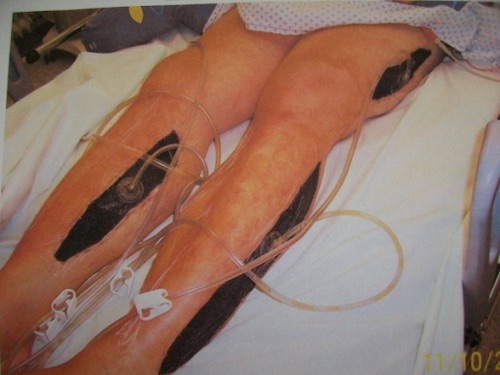
WVAC Closure 1
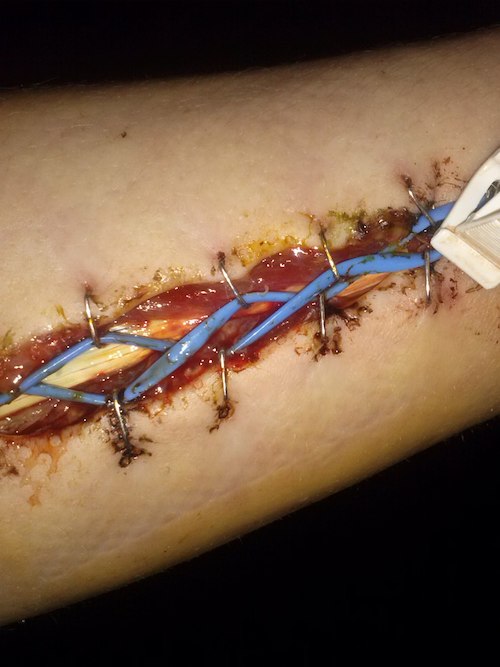
“Shoelace” Closure 2
Upper Extremity Fasciotomies
Upper Arm Fasciotomy
- Single Incision from Deltoid Insertion to Lateral Epicondyle
- Incise Anterior Fascia to Release Anterior Compartment
- Incise Posterior Fascia to Release Posterior Compartment
Forearm Fasciotomy
- Volar (“Henry”) Incision:
- Start Proximal Over Medial Epicondyle
- ‘S’ Curve Laterally Over Antecubital Fossa & Extended Medially Over Forearm
- Finish Over the Palmar Crease
- Release Volar Compartment & Lateral/Mobile Wad
- Dorsal Incision:
- Single Vertical Incision
- Release Dorsal Compartment
Hand Fasciotomy
- Two Longitudinal Dorsal Incisions Over 2nd/4th Metacarpals
- Longitudinal Incision Over Medial Aspect of 5th Metacarpal
- Longitudinal Incision Over Lateral Aspect of 1st Metacarpal
- Tailor Fasciotomies to Symptoms
- All Should Also Have Carpal Tunnel Release
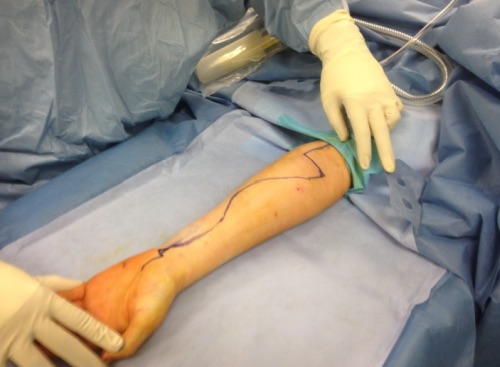
Forearm Fasciotomy Incision 3
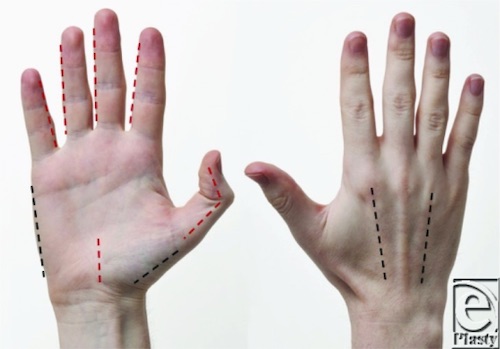
Hand Fasciotomy Incisions 4
Lower Extremity Fasciotomies
Buttock Fasciotomy
- Longitudinal Incision – Not Standardized
- Release All Three Muscle Compartments
Thigh Fasciotomy
- Release Anterior & Posterior Compartments
- Can Use Single Lateral Skin Incision or Two Separate Anterior/Posterior Incisions
- Can Include Medial/Adductor Incision
- Can Omit – Rarely Develops Compartment Syndrome
Calf Fasciotomy
- Double-Incision Fasciotomy
- Most Common Approach – Easier to Access Deep Posterior Compartment
- Anterolateral Incision:
- 15-20 cm Vertical Incision Midway Between Tibia & Fibula
- Incise Anterior Fascia Just Anterior to the Intermuscular Septum
- Incise Lateral Fascia Just Posterior to the Intermuscular Septum
- Protect Superficial Peroneal Nerve (Around Neck of Fibula)
- Most Common Injured Nerve – 10-12 cm Superior to the Lateral Malleolus
- Protect Superficial Peroneal Nerve (Around Neck of Fibula)
- Posteromedial Incision:
- 15-20 cm Vertical Incision 1-2 cm Posterior to Posterior Border of Tibia
- Retract Saphenous Neurovascular Bundle Anteriorly
- Incise Superficial Posterior Fascia Just Under the Skin Incision
- Detach the Soleus from the Tibia to Access/Incise the Deep Posterior Fascia
- Single-Incision Fasciotomy
- Skin Incision: 15-18 cm Lateral Incision Just Anterior to Fibula
- Anterior Compartment: Directly Incised
- Lateral Compartment: Directly Incised
- Superficial Posterior Compartment: Raise a Small Posterior Flap to Access
- Deep Posterior Compartment: Reflect the Soleus from Fibula Through the Posterior Flap
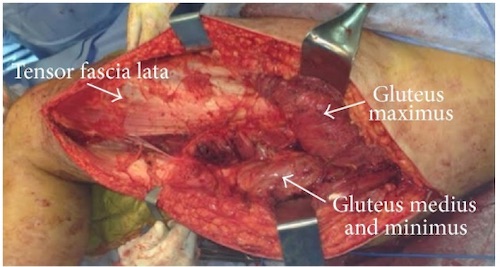
Buttock Fasciotomy 5
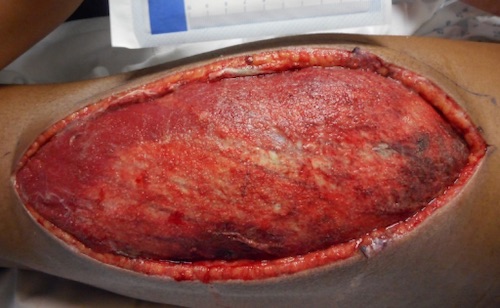
Thigh Fasciotomy 6
Foot Fasciotomy
- Dual Dorsal Incisions:
- Medial Incision – Along Medial Margin of Second Metatarsal
- Releases 1st/2nd Interosseous, Medial & Deep Central
- Lateral Incision – Along Lateral Margin of Fourth Metatarsal
- Releases 3rd/4th Interosseous, Lateral, Superficial Central & Middle Central
- Consider Adding a Medial Incision to Release the Calcaneal Compartment
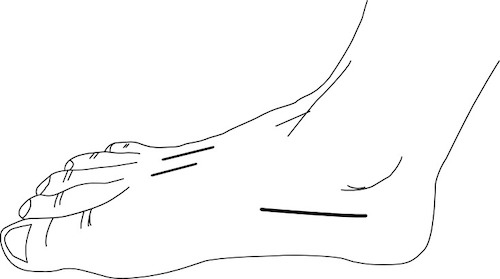
Foot Fasciotomy Incisions 7
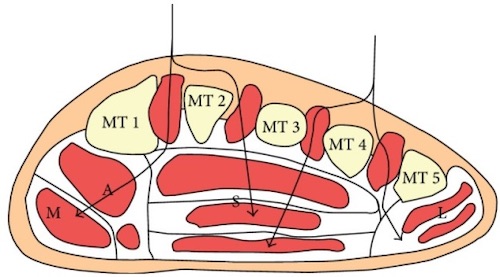
Foot Fasciotomy Depth 3
References
- Saugel B, Umgelter A, Martin F, Phillip V, Schmid RM, Huber W. Systemic Capillary Leak Syndrome associated with hypovolemic shock and compartment syndrome. Use of transpulmonary thermodilution technique for volume management. Scand J Trauma Resusc Emerg Med. 2010 Jul 5;18:38. (License: CC BY-2.0)
- Pomert T. Wikimedia Commons. (License: CC BY-SA-4.0)
- Raza H, Mahapatra A. Acute compartment syndrome in orthopedics: causes, diagnosis, and management. Adv Orthop. 2015;2015:543412. (License: CC BY-3.0)
- Gallagher E, Ruiter T. Spontaneous Arterial Hemorrhage of the Hand Resulting in Compartment Syndrome. Eplasty. 2015 Jul 31;15:ic44.(License: CC BY-2.0)
- Diaz Dilernia F, Zaidenberg EE, Gamsie S, Taype Zamboni DE, Carabelli GS, Barla JD, Sancineto CF. Gluteal Compartment Syndrome Secondary to Pelvic Trauma. Case Rep Orthop. 2016;2016:2780295. (License: CC BY-4.0)
- Felte R, Gallagher KE, Tinkoff GH, Cipolle M. A Case Review Series of Christiana Care Health System’s Experience with Negative Pressure Wound Therapy Instillation. Cureus. 2016 Nov 7;8(11):e865. (License: CC BY-3.0)
- Donaldson J, Haddad B, Khan WS. The pathophysiology, diagnosis and current management of acute compartment syndrome. Open Orthop J. 2014 Jun 27;8:185-93. (License: CC BY-NC-3.0)